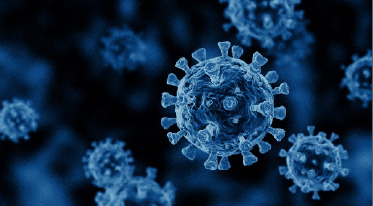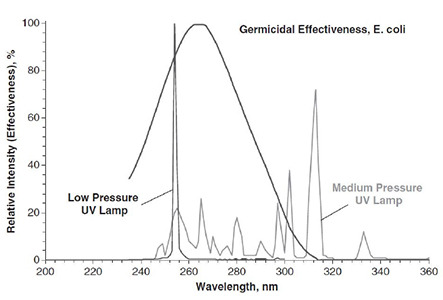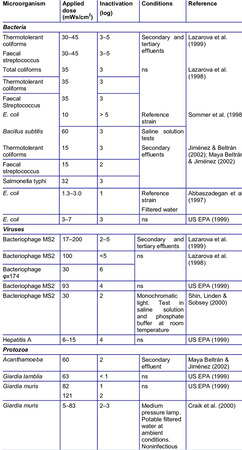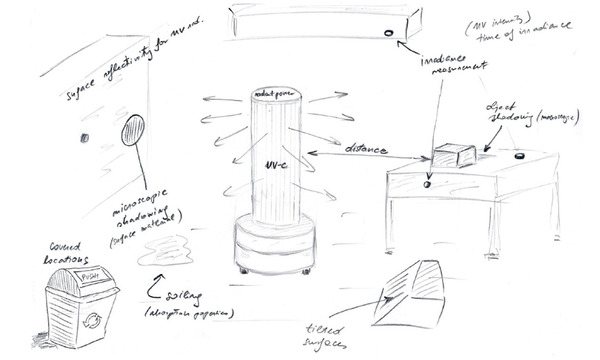First, there is the question of safety. As direct exposure to UV light has an impact on living organisms, all persons or other living creatures who shouldn't be exposed need to leave the room before disinfection starts. We should also take into consideration the material in the room as repeat exposure to UV-C radiation can lead to long-term deterioration of surfaces (especially polymeric).
Second, to make UV disinfection effective, the space that is supposed to be disinfected needs to be cleaned at the start, e.g. the absorption properties of liquids like blood will reduce inactivation success. All unnecessary objects creating macroscopic shadows should be removed. Rags on the floor or the interior of wardrobes are covered locations and the germs cannot be inactivated if they cannot be reached by the UV radiation.
There are different surface types and lots of crevices where bacteria and viruses can grow. When considering whole room environmental disinfection, it is necessary to use systems that can reach and are effective on every surface, including the floor, regardless of distance. For instance, there is a large difference in the UV-C irradiance at the Earth´s surface vs above the ozone layer of the atmosphere. We can draw an analogy to the situation occurring in our room. The measurement position with respect to the objects or substances in between the UV source and the irradiated surface is very important.
Third is the issue of exposure time. As irradiance is inversely proportional to the square of the distance from the UV source and the radiant power from the source is usually fixed, this distance and duration of exposure is crucial to achieve the needed dosage. Multiple UV sources can be combined; multiple systems installed on many corners, walls, ceiling, or moving robots would increase the available radiant power. With this approach, we can be assured that the log reduction corresponding to the required UV dose is achieved for specific type of pathogen in the room. To optimize disinfection results and use less time, it's ideal if the source moves close to the surfaces. The angle of the UV source tilt towards the irradiated object is also important as perpendicular surfaces will absorb more energy and micro shadowing due to the surface material texture can be approached more efficiently.
Coming back to UVGI safety issues, it´s important to note that there is a difference between the biological effect and the penetration depth of UV radiation. While the UV-C wavelength range is biologically the most active radiation, it is less dangerous to people because it is absorbed by the dead outer layer of skin. UV-B and UV-A radiation, on the other hand, penetrate further into the tissue. Safe practices are critical as an overexposure to 254 nm radiation can result in sunburn-like effects (erythema) and a painful eye condition known as "welder's flash" (photokeratitis) (1)
UV radiometers – also called irradiance and dosage sensors – are commonly used for UV irradiation and dosage measurement over the selected spectral band for disinfection applications. To achieve reliable results, it is crucial to select the right sensor and use it correctly. One way to measure the radiant power of the UV source is by using an appropriate integrating sphere connected to other sensors and a spectrometer. And finally, the proper calibration is what assures that the results obtained are accurate and reliable. Specific field conditions might require some special measurement approach or custom solutions.
Inactivating pathogens like a SARS-CoV-2 virus on surfaces with UV radiation can be an effective, safe, and environmentally friendly disinfection method, but it is essential to find a comprehensive approach that takes all limitations into account. There is a substantial need to improve regulations concerning the use of UV radiation for disinfection applications, especially in the healthcare industry. Developing and applying easy to use measurement equipment will be pivotal in this aspect.
Source 1: The History of Ultraviolet Germicidal Irradiation for Air Disinfection, N.G. Reed, Public Health Rep. 2010 Jan-Feb; 125 (1): 15-27





 Ultra-High Velocity
Ultra-High Velocity